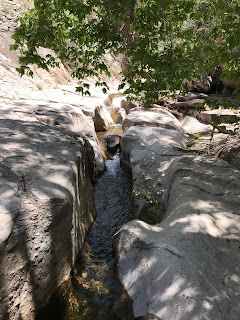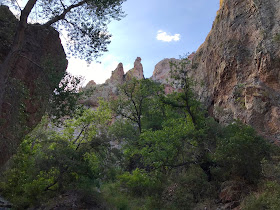Last year, when the store in Alma was the only place around to pick up supplies, Doug Scott and I drove up from Glenwood's Los Olmos Lodge to buy some bread and few other items. As we were leaving and heading back, I looked longingly down the Mineral Creek Road ( FR 701, also Catron County 007), and silently promised myself I would return soon.
A little more than a year later, I'm driving down this road a bit before seven in the morning, happy as I go for keeping my promise. There are two parking areas at the trailhead. I first parked in the outer one, but then as I saw a small, very vintage, pickup come out past the sign that points to Forest Trail 201, I got curious about how much farther the road went. I often make the mistake of parking further away than I need to, and decided not to this time. Turns out, it didn't matter as it was maybe, a bumpy 100 feet or less to the second parking area and the start of the trail.
Off I went, first on the well worn trail, and then onto the bedrock of the box canyon. Cliffs and towers of pinkish rhyolite rose up hundreds of feet on each side of me, dazzling in the early morning light. I saw a few fish, not trout, but dace, in the deeper water of a tight bend. I blind casted into a few likely spots with no results and then below the largest single waterfall ( perhaps 6 or 7 feet) of the several small ones in the box, I hooked and pulled up a healthy Gila that was 10 -11 inches or so. It put up more of fight than I expected. The Butterstick's extremely soft action contributed to this, but I got it released in a reasonable time, even if it was a bit longer than ideal.

I stayed with the creek, and not the trail from this point on, excepting a few stretches where the willows and alders grew so thickly on both sides of the shallow stretch of creek. Approaching the stream, and getting off a cast in these spots seemed like a waste of precious time given the lack of pools and the difficulty involved.
As I walked on, the fish were now in most any pool that was over a foot deep (and there were many much deeper), below small falls and where the stream ran dark under gray boulders. Sometimes I was casting my little coachman style dry fly into the clear, cold water, deep enough to hold a fish, or drifting it in and out of the froth. The larger ones would appear from the shadows for a lazy look, or slow take. Some stayed hooked, some did not. The smaller ones ( most around 7 inches) would dart out with unbelievable speed, so that at times I did a double take to see if my eyes were playing tricks on me. I knew soon enough when they were hooked and we were off to the races.
Other times I was casting to fish I could see, which I always feel is kind of a luxury, even though I usually get to enjoy it at least part of time on small streams like this. Watching the take is always fun, although being patient enough with the set was a little hard for me, now that I fish so much less often, but I did okay.
Large red and black dragonflies buzzed the pools, and I saw a trout throw itself out of the water at one. It would've been like Thanksgiving dinner had it been able to get it in its gullet. After that I did some false casting right above the pool's surface with my dry before letting it land. It worked.
Through the old mining camp of Cooney, there were foundations and walls, a tin roofed shack, a heavy iron safe, and other rusty artifacts. Various sizes of water pipeline, some still suspended by cables from the cliffs were there as well. There were still fish to be caught as well, although this section was probably the least shady.
Past a large headframe with concrete foundations and rusty ore processing machinery on the north side of the canyon, the valley narrowed and Mineral Creek seemed to transition into a middle elevation forest stream. There were still many idyllic pools to cast into as I continued to march upstream, catching and releasing fish as I went. Large boulders (though nothing on the scale of those I saw in Rain Creek) had fallen into the stream through this stretch. On the north facing hillside: red cliffs and bright green firs. On the south facing side were wavy black and white cliffs with ponderosa pines and juniper.



I had set my turnaround at 10:30, but as the weather wasn't threatening in the least, I continued on till 11:00. What a luxury it was to not be hurried. I had mostly gotten my fill of fishing, a rarity, and it wasn't even lunchtime. I followed the trail more on my return, but still threw a renegade fly into a few more pockets and still caught a few more fish. One of the last ones of the day was from a pool, fed by springs, rimmed with algae whose center was crystal clear in the bright sunlight, Several 9-12 inch Gilas, these with large black spots toward the back unlike most of the fish caught which were fine spotted all over, swam around unconcerned. I had a good hiding spot, but thought they'll never take the fly. It's too clear and too still. It took just a few casts, and I had one, maybe not the best, but still a beauty.
The algae made the fight and release a little problematic, as it had several other times during the morning. In retrospect it might have made more sense to just wade in and release from the deeper water. Note for the future.
I ate my lunch slowly around 12:00. Further on, back in the box canyon, I unzipped the bottom halves of my pants, took off shoes and socks and got right into the cold water below a waterfall. It hardly fazed me, the day had gotten so warm. I sat on the very warm bedrock afterwards and dismantled my rod and reel and then walked jauntily onward. I met a couple of guys and a dog named Zeke coming upstream. I told them what I had seen, and warned them about the poison ivy. I saw their wives resting in the shade a little further down. Wanting to snap a few more photos before I left, I noticed the large natural arch that I knew was somewhere along the creek but had not noticed on my way in. I was back to the truck at around 2:15. Perfect day.

A few comments on the Gila Trout in this stream: Some takes were hard, but many were very soft. A couple of times I was ready to pull back to cast only to realize there was a fish on my line. Some fish were real fighters, even as I tried to limit the time on the hook, one even did a couple of low leaps.Others gave up without much struggle. All had the golden Gila cast, but some were dull, and others were bright. With some, the purple parr marks were prominent and looked like the fish I had seen on Rain Creek, while others had none at all.
One last comment on Mineral Creek: Many places to fish and hike in the Gila have changed in the 25 years I've been visiting. Most, or nearly all not for the better. I had never been to Mineral Creek before, but gauging from Rex Johnson Jr.'s description in Fly Fishing Southern New Mexico (written in the mid-90s), this stream may be an exception. It appears, from the overgrowth of grass, and the lack of cow pies, that grazing pressure is absent ( at least for now). 10 to 20 foot alders line the stream which will eventually form a canopy. New growth of willows is present in many places as well.

The algae made the fight and release a little problematic, as it had several other times during the morning. In retrospect it might have made more sense to just wade in and release from the deeper water. Note for the future.
I ate my lunch slowly around 12:00. Further on, back in the box canyon, I unzipped the bottom halves of my pants, took off shoes and socks and got right into the cold water below a waterfall. It hardly fazed me, the day had gotten so warm. I sat on the very warm bedrock afterwards and dismantled my rod and reel and then walked jauntily onward. I met a couple of guys and a dog named Zeke coming upstream. I told them what I had seen, and warned them about the poison ivy. I saw their wives resting in the shade a little further down. Wanting to snap a few more photos before I left, I noticed the large natural arch that I knew was somewhere along the creek but had not noticed on my way in. I was back to the truck at around 2:15. Perfect day.

A few comments on the Gila Trout in this stream: Some takes were hard, but many were very soft. A couple of times I was ready to pull back to cast only to realize there was a fish on my line. Some fish were real fighters, even as I tried to limit the time on the hook, one even did a couple of low leaps.Others gave up without much struggle. All had the golden Gila cast, but some were dull, and others were bright. With some, the purple parr marks were prominent and looked like the fish I had seen on Rain Creek, while others had none at all.
One last comment on Mineral Creek: Many places to fish and hike in the Gila have changed in the 25 years I've been visiting. Most, or nearly all not for the better. I had never been to Mineral Creek before, but gauging from Rex Johnson Jr.'s description in Fly Fishing Southern New Mexico (written in the mid-90s), this stream may be an exception. It appears, from the overgrowth of grass, and the lack of cow pies, that grazing pressure is absent ( at least for now). 10 to 20 foot alders line the stream which will eventually form a canopy. New growth of willows is present in many places as well.

Gila Trout are here now as well, answering a question put forth in Johnson's book. A little over a thousand were put here in 2016 after ash laden floods post Whitewater Baldy fire removed the hybrid trout that had been there. They are a stock from a hatchery originally, but will hopefully continue surviving, adapting and reproducing well, perhaps one day reaching the numbers of the hybrid trout that were in this stream way back when.



















Great narration of a wonderful afternoon, one I've never gotten enough of. Thank You, John
ReplyDeleteThanks for the kind words. I revisited the piece and got out the typos. So thanks again.
ReplyDelete